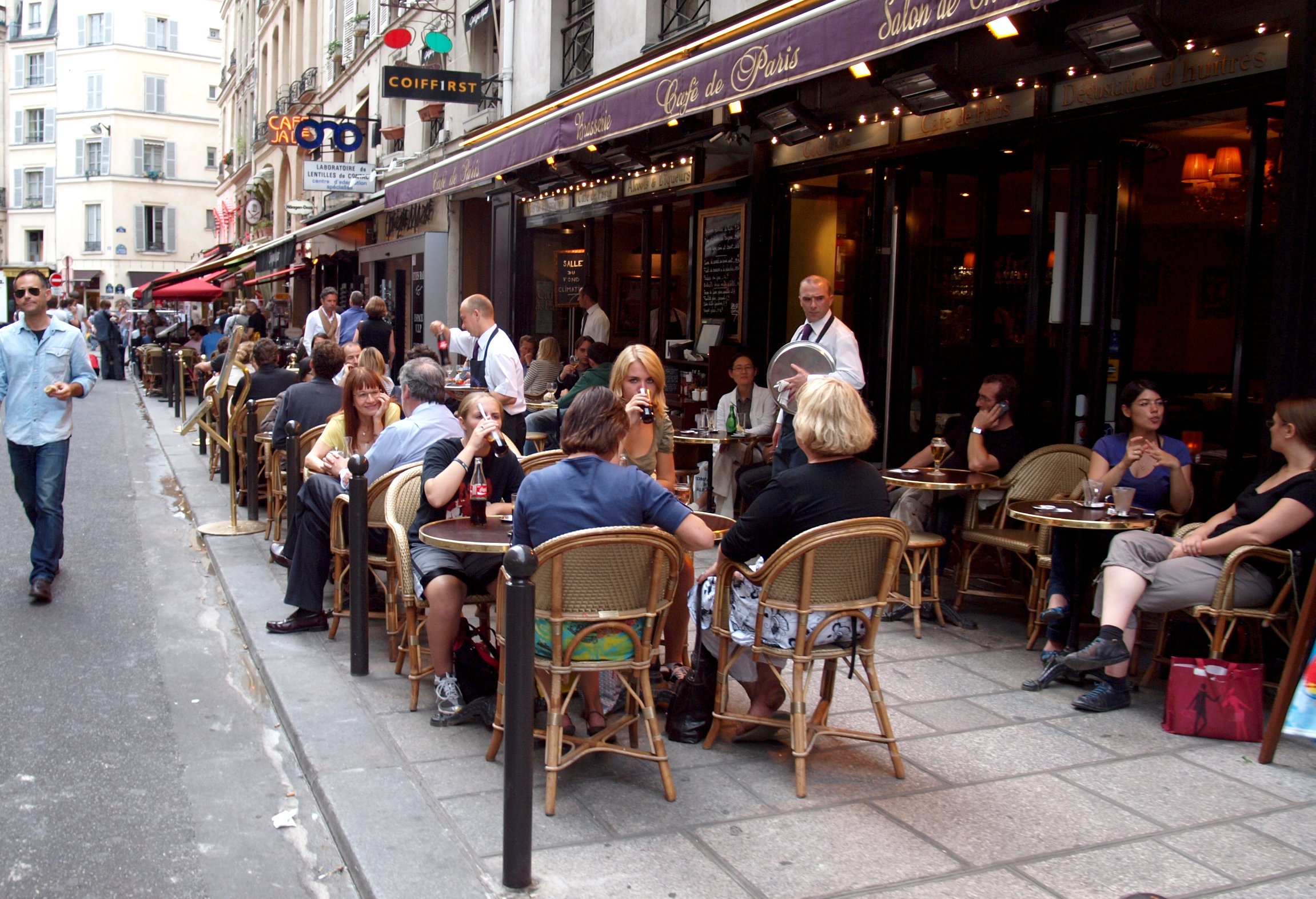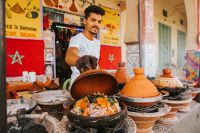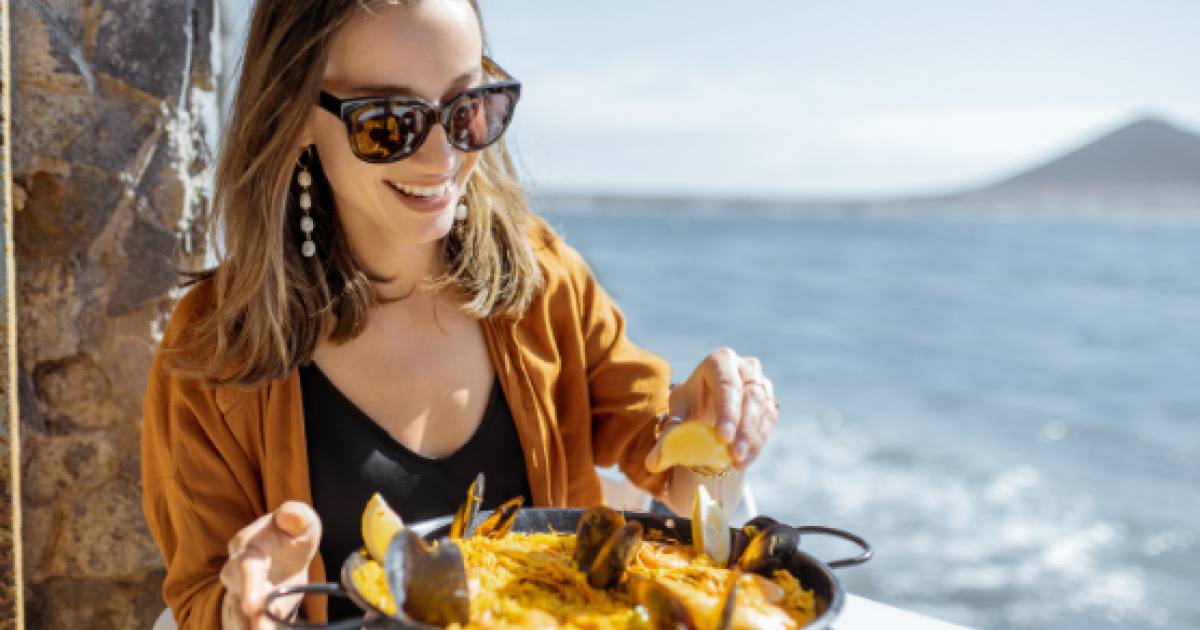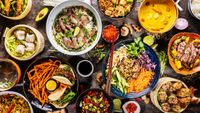Esplora i risultati di ricerca web relativi a questo dominio.

As many as 45% of Indian travellers consider food as an “integral part of their travel planning”, the India Holiday Survey Report by SOTC Travel recently revealed. From being a side dish to main course, culinary tourism has clearly seen a phenomenal rise in recent years, with food becoming ...
As many as 45% of Indian travellers consider food as an “integral part of their travel planning”, the India Holiday Survey Report by SOTC Travel recently revealed. From being a side dish to main course, culinary tourism has clearly seen a phenomenal rise in recent years, with food becoming one of the top parameters people consider when booking their holidays.As per SOTC’s surveys, cities like Delhi, Lucknow, Hyderabad, and Kolkata are the top destinations for culinary tourism. SD Nandakumar, president and country head, holidays and corporate tours, SOTC Travel, said, “Delhi, for instance, is a savoury sanctuary. When in Delhi you cannot miss the iconic chole bhature, chole kulche, daulat ki chaat, and sohan halwa. Lucknow’s food trails are famous for their rich flavours of Awadhi cuisine.Why culinary tourism also appeals to people is because of the rich experience it offers. Pushpesh Pant, an academic, food critic, and historian, said, “We live in times when everything is homogenised and all cafes serve the same food. People have a jaded palate and want to try out something more genuine and local while travelling.”The Future Market Insights Report in 2023 had estimated that India’s culinary tourism market was worth over $23 billion and was estimated to grow to over $182.5 billion by 2033. Rajeev Kale, president and country head of holidays, MICE, visa at Thomas Cook (India) Limited, told FE, “Our trends indicate a significant demand for gastronomical experiences during holidays, highlighting how food tourism is about appreciating the culinary heritage that showcases the history, culture, and ethos of a region.”
Culinary tourism differs from ... as the seeds of cuisine can be found in agriculture. Culinary/food tourism is not limited to gourmet food. Food tourism can be considered a subcategory of experiential travel....
Culinary tourism differs from agritourism in that culinary tourism is considered a subset of cultural tourism (cuisine is a manifestation of culture) whereas agritourism is considered a subset of rural tourism, but culinary tourism and agritourism are inextricably linked, as the seeds of cuisine can be found in agriculture. Culinary/food tourism is not limited to gourmet food. Food tourism can be considered a subcategory of experiential travel.Countries like Ireland, Peru, and Canada are making a significant investment in culinary tourism development and are seeing results with visitor spending and overnight stays rising as a result of food tourism promotion and product development. Food tourism includes activities such as taking cooking classes; going on food or drink tours; attending food and beverage festivals; participating in specialty dining experiences; shopping at specialty retail spaces; and visiting farms, markets, and producers. The World Food Travel Association estimates that food and beverage expenses account for 15% to 35% of all tourism spending, depending on the affordability of the destination.June 10, 2017, was the first annual National Food Tour Day, celebrating food tourism around the world. The World Food Travel Association introduced World Food Travel Day on April 18, 2018, as a way to put the spotlight on how and why we travel to experience the world's culinary cultures.It is designed to bring awareness to both consumers and trade, and support the Association's mission – to preserve and promote culinary cultures through hospitality and tourism. The day is celebrated all around the world every year on April 18. Food tourism offers a multitude of benefits for travelers, including:Culinary tourism became prominent in 2001 after Erik Wolf, president of the World Food Travel Association, wrote a white paper on the subject.

Moreover, the organization states that 53% of these travelers consider themselves “culinary travelers.” The compound annual growth rate for food tourism is expected to increase by 9% between the years 2019-2023 according to a recent report by Technavio, a market research company in the ...
Moreover, the organization states that 53% of these travelers consider themselves “culinary travelers.” The compound annual growth rate for food tourism is expected to increase by 9% between the years 2019-2023 according to a recent report by Technavio, a market research company in the United Kingdom.Food tourism, also referred to as culinary tourism and gastronomy tourism, is engaged in by individuals who seek out culinary experiences to broaden their understanding of a culture or lifestyle while traveling. Food tourists embark on tours that not only expand their palate, but afford them the education to identify the link between food and local customs.Food tourism evolved into an experiential industry that included festivals, wine tastings and other personalized offerings, as well as the advent of food-tourism companies. According to Robin Back of the University of Central Florida’s Rosen College of Hospitality Management, food tourists “pursue activities where authentic culinary and other food and beverage-related activities are the primary motivator for travel.Benefits of food tourism: According to the WFTA, food tourists spend about 25% of their travel budget on food and beverages. This can mean an increase in profits for a local community as well as the local government’s budget due to the taxes imposed on the goods purchased by tourists. This rise in revenue can afford local governments the ability to invest in marketing to tourists, which in turn can boost profits for local shops, restaurants, hotels and transportation services. An increase in culinary tourism can also instill in locals cultural pride and help ensure unemployment rates remain low, especially in rural areas with low economic activity.

Culinary tourism, also often referred ... food as a form of tourism. Whether that be eating, cooking, baking, attending a drinks festival or visiting a farmers market – all of these come under the concept of culinary tourism. It’s something you don’t even really need to travel to ...
Culinary tourism, also often referred to as food tourism, is all about exploring food as a form of tourism. Whether that be eating, cooking, baking, attending a drinks festival or visiting a farmers market – all of these come under the concept of culinary tourism. It’s something you don’t even really need to travel to do.When booking a trip, people tend to consider a variety of factors – and food is high on the list of priorities. The World Food Travel Association says that money spent on food and drink while travelling accounts for 15-35% of all tourism spending. Culinary tourism is important in that it generates so much money for local economies.Farmers markets: visiting a farmers market at the weekend to buy fresh produce is seen as a form of food tourism. Cooking classes: another activity you can get involved with on your travels is a cooking or baking class. You’ll often make, again, a local delicacy whether that be pierogi in Poland or pasta in Italy. Tasting sessions: brewery tours and vineyard visits (and other similar excursions) where you get to take a look at how something is made and then try it for yourself are another form of culinary tourism.If you have enjoyed this article about culinary tourism, or food tourism, then I am sure that you will love these too! What is pilgrimage tourism and why is it important? What is red tourism and why is it growing so fast? Overtourism explained: What is it and why is it so bad? ... Tourism Teacher is the leading tourism education website providing resources for students, teachers and anyone interested to learn more about the travel and tourism industry.

Food is one of the best ways to experience a culture, and food tourism, which is also called culinary tourism or food tours is a growing travel trend.
Do you ever find that the smell of local foods is one of your strongest travel memories? Food is one of the best ways to experience a culture, and food tourism, which is also called culinary tourism or food tours is a growing travel trend.…Do you ever find that the smell of local foods is one of your strongest travel memories? Food is one of the best ways to experience a culture, and food tourism, which is also called culinary tourism or food tours is a growing travel trend. Food tourism is simply a matter of traveling beyond your immediate neighborhood to find great food.Of course, the further you are willing to travel, the broader your range of culinary experiences will be. Basically, food tourism is the exploration of food as the purpose of tourism. As you have probably noticed foodie tourists share millions of food and photos daily across social platforms like Twitter, Facebook & Instagram.Culinary travel-based TV shows, food magazines and food and travel blogs has created a foodie focused traveler. Food Tourism encompasses many venues including cooking schools, culinary tours, wine tours, beer tasting tours, distilleries, and other culinary attractions such as farm to table eateries.

Since 2001, we've been at the forefront ... food and travel. With nearly 25 years of experience, we’ve gained deep industry insights. Let us put our expertise to work in helping you to elevate your destination through the power of food and beverage tourism. Are you an industry professional and not a destination marketer? Check out our Training, Recognition & Membership offerings instead. ... Intern with us and learn valuable professional skills in the culinary tourism ...
Since 2001, we've been at the forefront of gastronomy tourism, pioneering the indelible connection between food and travel. With nearly 25 years of experience, we’ve gained deep industry insights. Let us put our expertise to work in helping you to elevate your destination through the power of food and beverage tourism. Are you an industry professional and not a destination marketer? Check out our Training, Recognition & Membership offerings instead. ... Intern with us and learn valuable professional skills in the culinary tourism industry.Quebec was unsure of how to reach out to food-loving travelers. We performed custom culinary travel research, which helped the tourism ministry to improve its product development and enhance its positioning to food-loving travelers.We help destination marketers and stakeholders to develop and showcase their unique culinary cultures to travelers. © World Food Travel Association | All rights reserved.Learn about culinary tourism & how to benefit your business or destination.


It can include any experience you learn about, appreciate, consume, or indulge in food or drinks that reflect the local culture. The further the distance traveled, the more comprehensive the range of culinary opportunities. Culinary tourism isn’t solely about your food or the luxurious ...
It can include any experience you learn about, appreciate, consume, or indulge in food or drinks that reflect the local culture. The further the distance traveled, the more comprehensive the range of culinary opportunities. Culinary tourism isn’t solely about your food or the luxurious restaurants you splurge on.Culinary tourism is a cornerstone of the modern travel industry. It directly contributes to both the hospitality industry and the overall economy. The development of food culture can help a tourist destination draw new visitors.Since food often reflects an entire nation’s eating habits, culinary tourism can teach visitors valuable cultural lessons. Countries are often associated with particular foods – people will travel worldwide to eat the best pizza in Italy or the best ramen in Japan.While traveling, food also becomes a social opportunity. Dining is a time for families to enjoy food and chat about their experiences. The need for authentic dining grows as the drive for new experiences increases. Authenticity in the culinary world often lies in simple, farm-to-table ingredients. The more rooted in a region, the more likely the food will draw visitors’ attention. The global culinary tourism market was valued at $1,116.7 billion in 2019.

In an era where travel enthusiasts increasingly seek authentic and immersive experiences, gastronomic tourism has emerged as a unique avenue for exploring the culture and traditions of a destination through its food. As a result, the concept of gastronomic tourism has gained traction over the years, shaping how people view global culinary ...
In an era where travel enthusiasts increasingly seek authentic and immersive experiences, gastronomic tourism has emerged as a unique avenue for exploring the culture and traditions of a destination through its food. As a result, the concept of gastronomic tourism has gained traction over the years, shaping how people view global culinary scenes.As the name suggests, gastronomic tourism is a modern form of globetrotting where people travel across the world to sample cultural diversities through their cuisines. This exploration involves a wide range of activities, including visiting breweries, food spots, trying out local dishes, and participating in cooking classes or food festivals. Some tourists prefer wandering through local food markets as a way of learning about the culinary traditions, history, and culture of a country or people.Culinary tourism and gastronomic tourism are often used interchangeably to describe modern travel experiences centered on culinary pursuits. However, the two phrases have subtle differences worth noting. Culinary tourism focuses more on the culinary aspects of local cuisines, including the diversity of dishes, cooking techniques, food festivals, and food-related events.In essence, culinary tourism centers on the food itself, including its taste, presentation, and culinary techniques, while gastronomic tourism emphasizes culinary expressions as a means to understanding culture and lifestyle.For example, eating Dutch food is a way of getting immersed in Amsterdam culture or tasting berlin food specialties is a method to take a deeper approach on Germany. Gastronomic tourism offers a range of benefits to the tourism industry, communities, and travelers, including:
Foodie adventures and dream jobs await! Explore how you can combine culinary passion and travel with a career in food tourism.
Food can serve as a powerful lens, allowing us to more fully experience new destinations, which is one reason food tourism is a growing trend. According to some private-sector research, a majority of travelers research restaurants before heading out on vacation. But some travelers take it a step further. A recent report by the World Travel Association (WFTA) found that 34% of travelers select their destination based on food. This growing interest in connecting travel and the culinary world raises the questions: What is food tourism and what careers exist in the industry?The increasing popularity of culinary tourism is creating unique opportunities for both chefs and food influencers. There are many ways you can combine your passion for food, culinary experiences, travel, or your local area into money-making opportunities.Help take travelers past the tourist hotspots to find the best authentic dishes and culinary experiences the locals love in your city. Lead groups to the best restaurants, sharing what dishes will meet their needs. Take them on behind-the-scenes tours of the restaurants or create experiences where they can meet the Executive Chef. With the increase in food tourism, cities are working to create new experiences to help draw tourists.Food tourism is a travel trend that is here to stay. It provides transformative experiences for travelers, allowing them to immerse themselves in unique flavors, local culture, and regional traditions. The travel landscape continues to evolve with the changing generations, creating new and exciting opportunities in the culinary and hospitality world.


But for many travelers, experiencing a destination's culinary landscape is at the top of their to-do list. Whether it's a street taco crawl in Mexico City, Champagne tasting at a family-run cellar in France or soaking up the tapas culture in Madrid over a glass of vermouth and a plate of croquetas, global food tourism ...
But for many travelers, experiencing a destination's culinary landscape is at the top of their to-do list. Whether it's a street taco crawl in Mexico City, Champagne tasting at a family-run cellar in France or soaking up the tapas culture in Madrid over a glass of vermouth and a plate of croquetas, global food tourism has boomed in recent years and is expected to keep growing — from an estimated $1.54 billion market in 2023 to a projected $4.12 billion market in 2029.TOURISM WESTERN AUSTRALIA ... Western Australia — the westernmost part of the country and home to the Margaret River wine region — is already well known for culinary delights like fresh seafood, black truffles and world-class wines. In November, the second-ever Pair'd Margaret River wine and food festival (typically in mid-November) will celebrate the region with wine tastings and a roster of events that range from foraged-ingredient lunches to dreamy beachfront dinners.A foodie's month-by-month guide to culinary adventures in 2025.Head for New Zealand's west coast for the family-friendly Wildfoods Festival in Hokitika (March 8), showcasing the country's rich and diverse culinary landscape. Expect to sample Maori foods like wild boar and huhu beetle grubs and maybe even compete in a wearable art contest.
Food tourism, also known as culinary tourism, plays a vital role in how tourists make important vacation decisions. Food tourists (or culinary tourists) seek travel destinations with rich culinary histories, exciting attractions, and delicious food.
Whether it’s a new restaurant or a famous watering hole, food and beverage will always play a significant role in deciding where people travel. · Food tourism provides experiences revolving around food and beverages that show true value and respect for a destination’s local culture, history, and environment. · From a marketing perspective, food or culinary tourism should be an incredibly important part of your marketing strategy.Food tourism focuses heavily on cultural immersion, environmental impact, economic development, and creating memorable experiences for (hopefully) repeat travellers. · Food tourism aims to achieve this by creating a greater sense of community pride around local culinary culture, attracting culturally engaged tourists, and encouraging people to spend money locally and support small businesses.As the world becomes increasingly homogenised, preserving culinary heritage has never been more crucial. Food tourism plays a vital role in safeguarding traditional recipes, cooking techniques, and food rituals from the threat of globalisation. By supporting local farmers, markets, and eateries, travellers contribute to preserving culinary diversity.Whether you realise it or not, food tourism / culinary tourism plays a vital role in how tourists make important vacation decisions. Learn more »


The World Food Travel Association works with destination marketers and their stakeholders to facilitate the discovery and appreciation of unique culinary cultures by travelers.
We help destination marketers and stakeholders to develop and showcase their unique culinary cultures to travelers. © World Food Travel Association | All rights reserved.Our judges have completed their final deliberations and we are pleased to announce the finalists and winners of our Association's 2024 Global Culinary Travel Awards.Audrey is the co-owner and head pizza maker at Audrey Jane’s Pizza Garage in Boulder, Colorado in the USA, which she runs with her brother, Peter. After studying pizza-making under Tony Gemignani, she opened her restaurant, and achieved quick success, with the restaurant having been been featured on the Food Network; the Travel Channel; and Diners, Drive-Ins and Dives.

Food tourism, also known as culinary tourism, plays a vital role in how tourists make important vacation decisions. Food tourists (or culinary tourists) seek travel destinations with rich culinary histories, exciting attractions, and delicious food.
Whether it’s a new restaurant or a famous watering hole, food and beverage will always play a significant role in deciding where people travel. · Food tourism provides experiences revolving around food and beverages that show true value and respect for a destination’s local culture, history, and environment. · From a marketing perspective, food or culinary tourism should be an incredibly important part of your marketing strategy.Food tourism focuses heavily on cultural immersion, environmental impact, economic development, and creating memorable experiences for (hopefully) repeat travellers. · Food tourism aims to achieve this by creating a greater sense of community pride around local culinary culture, attracting culturally engaged tourists, and encouraging people to spend money locally and support small businesses.As the world becomes increasingly homogenised, preserving culinary heritage has never been more crucial. Food tourism plays a vital role in safeguarding traditional recipes, cooking techniques, and food rituals from the threat of globalisation. By supporting local farmers, markets, and eateries, travellers contribute to preserving culinary diversity.Whether you realise it or not, food tourism / culinary tourism plays a vital role in how tourists make important vacation decisions. Learn more »

Many places claim to be a culinary capital, but where are the world’s latest and greatest foodie hotspots? If you like to dine well on holiday – be it street food or Michelin star – you’re guaranteed great eats in one of these destinations.
Our food expert's round-up of the world’s latest and greatest foodie hotspots. Great holiday feasts and tasty flavours guaranteed.British food has undergone a revolution in the last twenty years; high-profile chefs such as Mark Hix and Fergus Henderson have sparked a culinary revival, with traditional flavours and dishes reinvented with contemporary techniques and ingredients.Green-leanings aside, culinary talent runs rampant in SF – in fact, the Bay Area is one of the three areas in the US that the Michelin Guide series rates. A long-standing immigrant community from the East translates to some of the best Asian food outside Asia.Across Tokyo’s dining scene, certain traits shine through – the frequent focus on seasonality and culinary technique, and the deep respect for chefs. Specialisation too – you’ll find no end of shops that have perfected just a single dish, whether that’s ramen, soba noodles, or sumo-sized hotpots. ... A foodie destination refers to a place that is renowned and sought after for its exceptional culinary experiences.
In this blog post, we'll look at what culinary tourism entails, its incredible benefits, why it's becoming increasingly important in today's world, and why it's such a focus for Curata Travel! What is Culinary Tourism? Culinary tourism, also known as food tourism or gastronomic tourism, involves ...
In this blog post, we'll look at what culinary tourism entails, its incredible benefits, why it's becoming increasingly important in today's world, and why it's such a focus for Curata Travel! What is Culinary Tourism? Culinary tourism, also known as food tourism or gastronomic tourism, involves traveling to different destinations with the primary purpose of experiencing the local food and beverage offerings.It goes so far beyond simply equating Italy with things like pasta and pizza! The Benefits of Culinary Tourism Cultural Immersion Food is a universal language that transcends borders, and by indulging in local cuisine, travelers can gain profound insights into the customs, values, and way of life of a particular destination.Economic Impact Culinary tourism also contributes significantly to the economic growth of destinations. Local restaurants, markets, food tours, and culinary events stimulate the hospitality industry and support small-scale producers and artisans. Curata Travel strives to seek out, support, and develop deep relationships with these small producers and food artisans and we love sharing their stories with our travelers.Social Connection Sharing a meal is a deeply communal experience, and culinary tourism facilitates · social connections between travelers and locals. Whether it's striking up a conversation with a street vendor, bonding with fellow food enthusiasts on a culinary tour, or learning a family recipe from a local chef, food has a remarkable ability to bring people together, fostering cross-cultural dialogue and understanding.


One of their solutions is to reimagine food tourism in the country. Based on the 2020 Food Travel Monitor, 7.2 out of 10 travelers select their destination based on its food and drinks. In the Philippines, nearly 30% of the total expenses of international tourists are allocated to culinary ...
One of their solutions is to reimagine food tourism in the country. Based on the 2020 Food Travel Monitor, 7.2 out of 10 travelers select their destination based on its food and drinks. In the Philippines, nearly 30% of the total expenses of international tourists are allocated to culinary experiences, as per the Department of Tourism’s statistics.Fast forward to 2024, see how culinary tourism in the Philippines fared with tourists now that COVID-19 restrictions are less strict. ... In 2023, food emerged as the top financial motivator for travelers.Even before recent years, certain countries have been capitalizing on local food tourism to attract visitors. Italy and France are recognized leaders in global gastronomy, celebrated for their distinctive cuisines, wines, and prestigious dining venues. · They’re known for enriching culinary tours, from Tuscany’s fresh pasta to Bordeaux’s wine explorations. Italy ranks as the top choice among travelers, followed by France, with areas like Tuscany, Piedmont, and Umbria favored for their exceptional value, particularly among families seeking culinary adventures.Still, former Tourism Secretary Bernadette Romulo-Puyat worked on recommendations for health and safety guidelines for restaurants, cafes, and other dining establishments, in the hopes that food will help fuel the return of tourism. According to her, by actively seeking out and indulging in local cuisine or delicacies, travelers forge profound connections with a region and its inhabitants, creating unforgettable experiences. Additionally, a report by Future Market Insights stated that the Philippines is expected to experience a significant surge in the popularity of culinary tourism.
Culinary tours for every taste: from Italian pizza to New York bagels and street food in Bangkok. Feast on some of the best food tours in the world!
We celebrate many experiences over a feast, from Christmas dinners to birthdays, and traveling is no different. Toast newfound friends over street food, or rekindle the romance amongst the vineyards on a couples’ food tour · Whether you’re truffle hunting in Italy, farming rice terraces in Indonesia, following the aroma of spices to Moroccan souks or learning how to make authentic daal, create your own culinary masterpiece in a cooking classFrom baba ganoush to bruschetta, the world’s culinary delights are simply irresistible and hard to pass if you have certain dietary requirements. Most of our tour operators will cater to vegan, vegetarian, halal, kosher, or Jain options upon request, and our Food & Culinary adventures are no different! Simply find a tour to your taste and send our Travel Experts a message.Find your next Food & Culinary adventure by browsing through our tours until you find one to your taste. Then simply pick your dates and fill out your details before you secure your next organized adventure. If you have any questions along the way, our Travel Experts are standing by 24/7!Some of our Food & Culinary tours even already include a wine tasting, so be sure to check your itinerary for details. If not, then add on a wine-tasting trip to tantalize your tastebuds! Of course! The majority of our tour providers accommodate dietary restrictions upon request. Simply write a message to our Travel Experts with your dietary requirements and we will assist you so that you can enjoy your foodie tour to the fullest.


It will also show how individuals can be encouraged to indulge in ‘food tourism’ and gain life-long learning with experience. ... Travelling to various regions in order to seek a food centric experience is known by numerous names. It may be called culinary tourism, gastronomic tourism, ...
It will also show how individuals can be encouraged to indulge in ‘food tourism’ and gain life-long learning with experience. ... Travelling to various regions in order to seek a food centric experience is known by numerous names. It may be called culinary tourism, gastronomic tourism, food tourism, cuisine tourism or even taste tourism (Smith, 2007).Boyne, S, Hall, D & Williams, F 2003, ‘Policy, Support and Promotion for Food-Related Tourism Initiatives: A Marketing Approach to Regional Development’, Journal of Travel & Tourism Marketing, vol. 14, no. 3-4, pp. 131–154. Crompton, J.L., 1979. Motivations for pleasure vacation. Annals of tourism research, 6(4), pp.408-424. Gunn, C. (1993). Tourism planning. New York: Taylor & Francis. Hall, C., Sharples, L., Mitchell, R., Macionis, N. and Cambourne, B. 2011. Food Tourism Around The World: Development, Management and markets. New York: Routledge. Long, L. (2003). Culinary tourism.Analysis of tourists attending a culinary event: Motivations, satisfaction, and behavioural outcomes. Thesis (PhD). The University of Tennessee, Knoxville. Telfer, D.J. and Hashimoto, A., 2011. Food tourism in the Niagara region: The development of a nouvelle cuisine. In Food tourism around the world (pp. 170-189). New York: Routledge. United Nations World Tourism Organisation 2016. The Power of Youth Travel.1 Project (research topic) title Travel Motivation for Young Adults: The role of Food Tourism 2 Project (research topic) summary This researc
This includes food and beverage ... media, and academia. The World Food Travel Association helps to bring these disparate sectors together under the umbrella of the “food tourism industry cluster.” Explore Our Culinary Placemaking...
This includes food and beverage businesses, travel and hospitality businesses and some other related businesses and organizations such as governments, media, and academia. The World Food Travel Association helps to bring these disparate sectors together under the umbrella of the “food tourism industry cluster.” Explore Our Culinary PlacemakingWe use “food travel” and “food tourism” interchangeably. We began with this phrase when our industry was young, but we realized after 10 years, that native English speakers found the phrase a bit pretentious. That surprised us as this was never our intent. Still, the elitist perception of the phrase remains. “Culinary” echoes time spent in professional culinary training to become a chef.For Europeans, “food travel” sounds very basic and banal – almost like cavemen hunting for food or a modern human searching for food in a grocery store. For Europeans, “gastronomy” is the term used to explain an area’s culinary culture, and for them, it follows that “gastronomy tourism” makes the most sense.In these areas, we find it perfectly acceptable to use the term “gastronomy tourism.” · The overall culinary and gastronomy heritage of a destination. This includes customs, traditions, recipes, dishes, cooking techniques, utensils, cooking stories, unique ingredients, and history. This describes a destination development strategy to put a destination on a food lover’s map by identifying all food and beverage resources, bringing them together, weighing their value, assessing market forces, and engaging fundamental stakeholders.


Today’s travellers are searching for a cultural experience, finding the best places to taste the ‘real’ local cuisine. Food Travel is the big trend for 2024
“Today’s travellers are searching for a cultural experience, finding the best places to taste the ‘real’ local food, just like the locals eat.” Food travel may be gaining steam but it is not a new concept. Asia's top destinations such as Thailand, India, Indonesia and Japan have always been known for their food.Bali and its smaller island neighbour Lombok are right up there in the exotic food stakes of Asia, where dining can be as ceremonial as the daily temple rituals you see as you travel around the islands. The famous Balinese rijsttafel offers an outstanding introduction to culinary Indonesia with up to 40 dishes served from around the world’s largest archipelago in a fusion of Indonesian and Dutch colonial influences.“These days, travellers have become more focused on food experiences as an important part of their travels, seeking out the exceptional restaurant or local dish to share on Instagram, learning more about the provenance of the dishes, the ingredients and the stories behind what they eat.” It is no longer about ticking off a standard Thai curry from their list. · Santi is one of a breed of chefs and restaurateurs who are driving this trend of putting dining and culinary experiences at the forefront of the tourist experience in Asia and driving food travel.You can also immerse yourself in the local culinary culture through in-villa cooking classes. Your in-villa chef will be happy to take you on a market tour, culminating in a cooking experience in your villa. Not only do you get to sample local cuisine, but also take back the knowledge of how to make it in your home.











